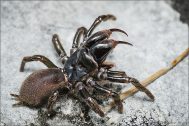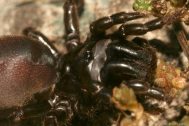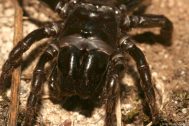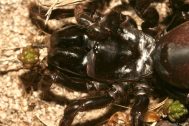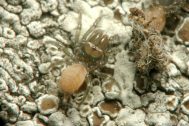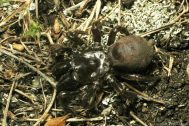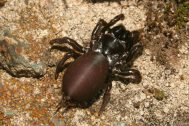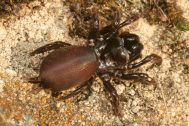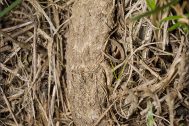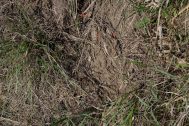| Records by time | |||||
|---|---|---|---|---|---|
| Atypidae | 0-1900 | 1901-1950 | 1951-2000 | 2001+ | ∑ |
| Atypus muralis Bertkau, 1890 Strongly endangered | 1× | 6× | 51× | 26× | 84× |
Atypus muralis Bertkau, 1890
| Czech name | sklípkánek pontický |
|---|---|
| Threat level | Strongly endangered |
| Records | 84 nálezů, 16 kvadrátů |
| First record |
1898, A. Nosek, Nosek 1898 |
| Last record | 2017 , Radek Šich |
| Distribution area | Palaearctic - E-T, ME |
| Phytogeographic area |
|
| Původnost stanovišť |
|
| Humidity |
|
| Stratum |
|
| Osvětlení stanovišť |
|
| Hojnost výskytu |
|
| Altitude | 200-450 |
Bibliography
Habitat selection by threatened burrowing spiders (Araneae: Atypidae, Eresidae) of central Europe: evidence base for conservation management.
Habitat selection in sedentary, long-lived burrowing spiders is a key life-history event that directly affects their reproductive success. In this study, we analyzed the role of the chemical and physical properties of soil in habitat selection by threatened temperate burrowing spiders. We examined 296 burrows of three Atypus spp. and three Eresus spp. at 68 sites in Czechia. We found that the study species were associated with soils that have high or very high cation exchange capacity, which allows the presence of a stable nd humid microclimate in their burrows. We found that specific bedrock types can be used as predictors of the presence of particular study species. All Eresus spp. avoided compacted soils. However, when present in soils with very low penetration resistance, they were limited to sites with high soil cohesion. The burrows of all study species were located at well-drained sites. The study species seemed to be selective for a steppe-like character of their microhabitat but not necessarily for its southward orientation. We found the study species even at sites where steppes were present in the early 1950s and that underwent later afforestation but not extensive landscaping or plowing. What types of disturbances can be sustained by the study species and how long it takes the decreased populations to recover after, e.g., trampling associated with grazing, remain to be investigated.
Příspěvek k výskytu sklípkánka Atypus muralis Bertkau, 1890 a stepníka Eresus kollari Rossi, 1846 na Prostějovsku.
Příspěvek pojednává o nálezu izolované populace Atypus muralis a Eresus kollari na Prostějovsku.Pavouci kavylové stepi u Brozan v dolním Poohří (severní Čechy).
V letech 2008 a 2010 bylo sledováno společenstvo pavouků (Araneae) sprašové stráně za hřbitovem v katastru obce Brozany nad Ohří (číslo faunistického čtverce 5550, 50°27´43˝N, 14°07´48˝E, 170 m n. m., Obr. 2). Tato lokalita je charakterizovaná jako v rámci Čech unikátní kavylová step na černozemní půdě na sprašové návěji (Řezáč 2009) s typickými xerotermo- filními rostlinnými druhy (Astragalus exscapus, Adonis vernalis, Verbascum phoeniceum, Stipa capillata aj.). Již po několik let je známá výskytem sklípkánků (Atypus sp.). Jejich nory s charakteristickými trubicovitými pavučinovými vyústěními (punčoškami, Obr. 3) zde objevil při botanickém průzkumu lokality Jan Novák a později pravidelně pozoroval Pavel Moravec (in verb.). Dosud nebyl k dispozici žádný dokladový vzorek, avšak Řezáč (2009) předpokládal podle charakteru lokality výskyt sklípkánka pontického, Atypus muralis Bertkau, 1890 (Obr. 4).The distribution of purse-web Atypus spiders (Araneae: Mygalomorphae) in central Europeis constrained by microclimatic continentality and soil compactness.
Aim Three species of primitive spiders of the genus Atypus occur in European xerothermic habitats, where they live in burrows. The aim of this study is to explain their distribution by investigating environmental variables at sites where they occur in central Europe.
Location Over 50 sites in central Europe, Czech Republic.
Methods Data on climatic, edaphic and vegetational parameters were collected from more than 50 sites. Phytocenological data were processed using Ellenberg’s indicator values.
Results Atypus muralis was found to occur almost exclusively in dry grassland (Festucion valesiacae), exposed to a continental microclimate. Atypus affinis usually occurred in dry sparse forests (Genisto germanicae–Quercion) that provide an Atlantic microclimate. Atypus piceus occurred in dry grassland (Bromion erecti) or forest fringes (Geranion sanguinei) characterized by an intermediate microclimate. Atypus piceus and Atypus muralis were restricted to agglutinate calcareous soils.
Main conclusions Our results show that Atypus species colonized sites with different continentality in central Europe. These differences correspond to differences among their probable glacial refugia. Atypus muralis and Atypus piceus occur in habitats with a markedly continental climate, and are restricted to calcareous agglutinate soils that more efficiently buffer temperature and humidity extremes. Habitats of Atypus muralis and Atypus piceus are threatened by overgrowth of vegetation after a recent decline in grazing and by the decalcification of the landscape. However, habitats of Atypus affinis are stable in the present central European climate.
Unusual karyotype diversity in the European spiders of the genus Atypus (Araneae: Atypidae).
Compared with araneomorph spiders, karyotypes of the spider infraorder Mygalomorphae are nearly unknown. In this study we investigated karyotypes of European species of the genus Atypus (Atypidae). The male karyotype of Atypus muralis and Atypus piceus comprises 41 chromosomes, whereas female complements contain 42 chromosomes. On the other hand, both sexes of Atypus affinis possess 14 chromosomes only. It is the lowest diploid number found in mygalomorph spiders so far. Furthermore, obtained data suggest X0 sex chromosome system in Atypus piceus, Atypus muralis and neo-XY system in Atypus affinis. Karyotypes of all three Atypus species are composed of biarmed chromosomes only. Thus they differ significantly from the karyotype of A. karschi , the only other species of this genus studied so far. Its karyotype was reported to be composed of acrocentric chromosomes and possesses X1X20 sex chromosome system. All this shows that unlike in most genera of araneomorph spiders, mygalomorphs of the genus Atypus exhibit unusual diversity in the number, morphology of chromosomes, and the sex chromosome system. Considering high number of chromosomes being plesiomorphic character in spiders, then karyotypes of Atypus muralis and Atypus piceus represent ancestral situation and that of Atypus affinis being derived by multiple fusions. Karyotype differences in Atypus correspond with morphological differences, namely the number of segments of the posterior lateral spinnerets. Thus in contrast to published hypothesis, the 3-segmented posterior lateral spinnerets of Atypus affinis should present a derived state.
Gallery
Statistics
By month
By altitude
By collecting method (84 used records)
| Atypus muralis Bertkau, 1890 EN | Males | Females | Juveniles | Records |
|---|---|---|---|---|
| Neurčeno | 7 | 13 | 0 | 43 |
| Zemní past | 26 | 1 | 2 | 20 |
| Individuální sběr | 4 | 4 | 2 | 13 |
| Fotografie | 0 | 2 | 0 | 2 |
| Prosev | 4 | 1 | 0 | 6 |
| Males | Females | Juveniles | Records |
By biotope (84 used records)
| Atypus muralis Bertkau, 1890 EN | Males | Females | Juveniles | Records |
|---|---|---|---|---|
| Neurčeno | 11 | 5 | 0 | 55 |
| Xerotermní travinobylinná společenstva | 3 | 0 | 1 | 1 |
| Louky | 1 | 1 | 0 | 1 |
| Jeskyně | 0 | 2 | 0 | 2 |
| Suché louky | 4 | 12 | 3 | 8 |
| Skalní stepi na vápenci | 16 | 1 | 0 | 11 |
| Lesostepní doubravy | 5 | 0 | 0 | 5 |
| Louky a pastviny | 1 | 0 | 0 | 1 |
| Males | Females | Juveniles | Records |









